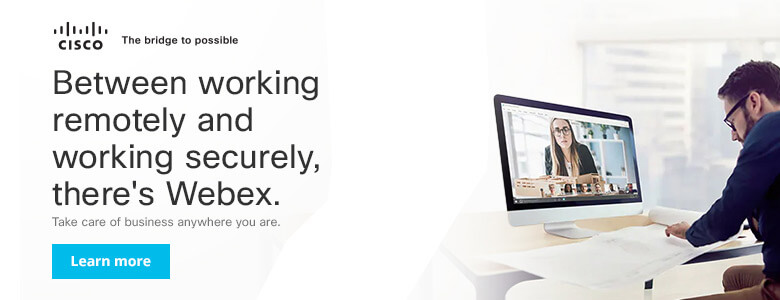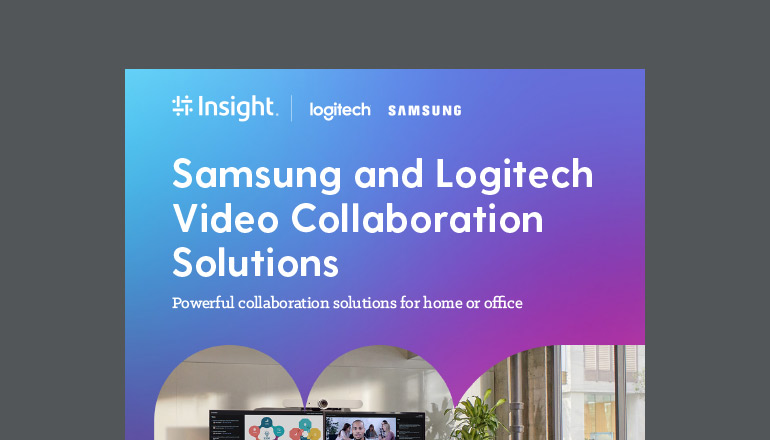Article The Future of Work: Collaboration
By Joe Flynn / 18 Jun 2020 / Topics: Collaboration Mobility Modern workplace Hybrid workforce

Collaboration solutions have been a valuable business aid in recent years — providing more flexibility, agility and productivity to workers on the go. And, now, these videoconferencing, instant messaging and content sharing tools are quickly becoming a business continuity necessity as we navigate the impacts of COVID-19.
Applications like Microsoft Teams and Cisco Webex make it just as effective to complete tasks away from the office as it in the office by unifying voice, video, instant messaging and content sharing in a single platform.
It’s now possible to complete a full day of work on the go from any device. You can still attend meetings and accomplish tasks from your home or on the go between appointments. All that’s required is a stable and secure internet connection.
Busy schedules can be easily accommodated, business travel can be more productive, and job and candidate pools are larger since you’re no longer limited to opportunities in one location.
Physical offices are changing, too. Businesses are adopting open concepts where desks are optional and conference rooms are in abundance to enable fluid work environments.
“COVID-19 definitely pushed the need for a holistic collaboration solution to the forefront, so remote workers can engage and collaborate better.”
According to an analysis of 2018 U.S. Census Bureau data by Global Workplace Analytics, remote work has grown 173% since 2005 with five million U.S. workers working from home at least half the time.
Collaboration solutions have become a critical component of most business continuity strategies to safeguard communities, workers and customers from the COVID-19 virus.
Transitioning to the new normal
For the last several years, voice and video solutions have been a staple. Content collaboration, though, hasn’t been as popular.
“Businesses were stuck with email or their shared drive,” says Joseph Flynn, director of services for Insight's Connected Workforce team. “Many organizations want content collaboration, but IT seemed to delay it. There was no value from an IT infrastructure or technology perspective.”
When stay-at-home orders went into effect around the globe, content collaboration and sharing solution demand grew. Many organizations had little time to create and execute strategies that would ensure their workforce could continue everyday tasks outside the office — leaving many in need of finding out how to adopt these tools.
COVID-19 pushed the need for a holistic collaboration solution to the forefront, so remote workers can engage and collaborate better.
Cisco Webex and Microsoft Teams have risen in usage since the shift to remote work.
“Zoom meeting” also quickly entered the cultural vernacular as schools, families and businesses adopted the solution.
Thanks to these tools, social distancing doesn’t mean you can’t be social both personally and professionally. Collaboration solutions help employees stay engaged with their colleagues and are useful in ensuring projects are finished like they were done in the office.
“Users will start to use more advanced features. And from there, they’ll start automating their own day-to-day tasks to make their jobs easier.”
Although integrating these solutions is easier than ever, the sprawling nature of the tools pose a unique challenge. How do you maximize value while maintaining your IT environment’s best practices?
Collaboration solutions don’t exist in a silo. They inherently bring people and their data together — requiring involvement from many business and IT units, including security, data, network, executive and human resources teams.
Your organization must establish governance policies that ensure regulatory compliance and employees require best practices training to ensure an effective adoption.
Driving value with collaboration
This new era of holistic collaboration solution adoption is going to bring many changes to both the way we work and the tools themselves.
Your end users — even the ones who might have resisted the adoption of your collaboration solution — will quickly become super users.
Users will start to tackle more advanced features. And from there, they’ll start automating their day-to-day tasks to make their jobs easier.
As we assess the impact of this global work-from-home environment, many organizations may come to realize that remote work is equal to office work, if not better. The face of offices could change even more as businesses determine the perfect mix of in-office and remote workers.
Business travel could be less of a priority, too, because it’s much easier and cost-effective to hop on a video call than fly long distances for a day or two of work.
This level of flexibility will lead to less travel time, which will drive more opportunity for productivity and customer interactions.
Providing collaboration solutions will no longer be a perk to highlight. It’s going to be an expectation from your end users, customers and the public.
Building a best-fit collaboration tool with an eye to the future
Organizations that quickly adopted new solutions in response to COVID-19 may need to take a step back and assess the success of their adoption. They’ll need to ask a few important questions:
- Is this tool contributing to short- and long-term business success?
- Are employees using these tools appropriately and responsibly?
- Are the right data security policies in place?
If the answers to those questions aren’t satisfactory, then adjustments need to be made by changing existing licenses or finding a new solution altogether.
When making these changes, business requirements should be the number one driver of change.
Working with a technology partner can help ensure your organization integrates and adopts a collaboration platform that meets all its needs and goals.
When Insight works with clients, every project starts with an assessment. A team reviews existing contracts and licensing and then compares capabilities with short- and long-term organizational goals.
A hunt for a new solution begins if the existing licensing isn’t providing the capabilities the organization needs or doesn’t use.
When an ideal solution is found, it’s time to create a proof of concept to ensure the solution will work as expected within the customer’s IT environment. Then, the project goes to a pilot program before being fully implemented.
But an adoption doesn’t end there. In some cases, integrating the technology is the easy part. There’s a challenge in making sure your users are happy with the solution and will use it.
If a workforce doesn’t like the solution and won’t use it, there’s a problem. Not only are you wasting money on a tool no one uses, but you can run into situations where employees download unapproved applications.
You’ll need to clearly communicate the value of these tools while also providing use-case training to support a successful adoption. This can be done by establishing an organizational change management strategy that engages your end users.
From there, the benefits of modern collaboration solutions will start to appear.
About the Author:
Special contribution by:
Related articles
Narrow your topic:
Collaboration Mobility Tech Journal Enterprise Connected Workforce View all focus areas


















